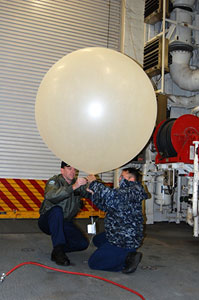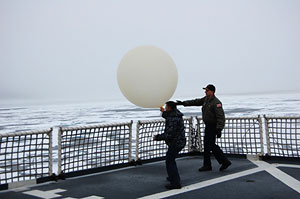

 | |||||||||||
|
|
Journals 2009/2010Jonathan Pazol
August 14, 2009 We're still heading north at about 4.5 knots (nautical miles) per hour - for those people who know ships, this is very slow. We should pass 80.00 N sometime later today, and tomorrow we should turn and head east so that the Louis can continue to use the seismic guns to map the thickness of the bottom sediment. It is still foggy and when the wind picks up, it is very cold. Whose idea was it to go to the Arctic in August when it's 90° F in Chicago? One of the other science activities that occurs on board is the collection of weather data. Twice daily, at 6 am and 6 pm, members of the Navy launch a weather balloon off the flight deck. AG1 (Aerographers Mate 1st Class) Richard Lehmkuhl is in charge of the operations. He is based in Norfolk, Virginia at the Naval Meteorology and Oceanographic Center, and in his 14 years of service has traveled the world. Supervising AG1 is Navy Commander William Sommer from the Naval Oceanographic Office in Stennis, MS. The Navy has formed a task force on climate change and is on board the Healy to work with and learn from the Coast Guard about arctic surface operations and engineering. These things include navigation through the ice, polar communications, weather forecasting, and developing ice prediction systems. AG1 Lehmkuhl is responsible for preparing the balloons. The equipment consists of a battery-powered radiosonde (small white box containing the transmitter), which hangs suspended from the balloon. The radiosonde contains a GPS transmitter and other sensors, which send information about wind direction, temperature, humidity, and air pressure back to the Healy. In the helicopter hangar, a large balloon is filled with helium and the radiosonde is attached.
Once the balloon is attached, it is carefully carried out to the edge of the flight deck, where it is released. This can be a tricky operation because handling a balloon with an almost 5-foot diameter in strong winds is difficult. The men have to be careful that the equipment does not bang into the flight deck and that the balloon flies off the ship without becoming entangled in any of the equipment on board. The balloon will travel up almost 6 kilometers (3.6 miles) until the air pressure drops to about 50 millibars, at which point it will expand so much that it pops. If it doesn't reach this altitude, the batteries will stop transmitting after about 2 hours.
The information from the radiosonde on the balloon is then transmitted back to the ship. AG1 Lehmkuhl collects the data and forwards it so it can be used to provide weather forecasts for the Navy, Coast Guard, other Department of Defense groups, and NATO units. |
||||||||||

